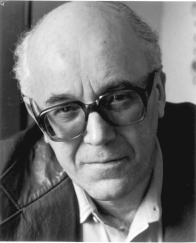Michel Philippot
Michel Paul Philippot was born on 2 February 1925 in Verzy (France). His first studies of mathematics were interrupted by World War II, after which he decided instead to study music, first at the Conservatory of Reims, and then at the Paris Conservatoire (1945–48), where he studied harmony with Georges Dandelot. He also took private composition lessons from 1946 to 1950 with René Leibowitz, who introduced him to the music of the Second Viennese School. In 1949 he began a career at ORTF in a position as a music producer. In 1959 he became assistant to Pierre Schaeffer in the Groupe de Recherches Musicales, and later worked under Henri Barraud at France-Culture. From 1964 to 1972 he was in charge of music programs, then became a technical adviser to the Director General of Radio France and to the President of the Institut National de l'Audiovisuel. From 1969 to 1976 he also taught musicology and aesthetics at the Universities of Paris I and IV, and from 1970 was Professor of Composition at the Conservatoire National Supérieur de Musique de Paris. In 1976 he moved to Brazil in order to create the department of music at the University of the State of São Paulo, as well as to take up a position as Professor at the Universidade Federal do Rio de Janeiro (Condé 2001). Upon returning to France in 1983, he resumed his occupation as technical advisor to INA (until 1989) and his professorship at the Paris Conservatory (until 1990) where he had as pupils notably Denis Cohen, Philippe Manoury and Nicolas Bacri.
Seeking to solve a musical problem with the help of existent or invented mathematical models, he developed a contrapuntal style as well as a procedure of thematic variation based on continuous transformation. Rejecting literary titles and cultivating purely instrumental genres, he composed symphonic pieces (Composition pour double orchestre, 1960; Carrés magiques, 1983), concertante works (Concerto for violin, viola and orchestra, 1984), works for chamber orchestra (Pièce pour 10 instruments, 1961; Passacaille for 12 instruments, 1973; Contrapunctus X for 10 instruments, 1994), string quartet or solo instruments (Sonata for piano, 1947) and some musique concrète (Etude de musique concrète n° 1, 1951).
His honors include the Grand Prix national de la musique (1987), and the presidency of the Académie Charles Cros.
Michel Philippot died on 28 July 1996 in Vincennes (France).
In my possession is the autograph full score of the work "Romance d'Hallewyn" by Michel Philippot. The work was composed in 1950 and is scored for voice, brass, timpani, percussion (bass drum, side drum, wood blocks, tamtam, cymbals), celesta and violas. It is one of the early compositions by the composer, previously unpublished and not part of the official work catalogue.
It is possible that the "Romance d'Hallewyn" is music to a stage play because the manuscript has several red writings above specific measures saying "apparation d'Hallewyn", "apparation de la vierge", "Danse d'exorcisme" or "Hallewyn seul".
The story of Hallewyn (or Halewyn, Halewijn, etc) is a medieval myth about a Lord Hallewyn who sings a magical song. Every woman who hears this song is drawn towards him and goes to meet him in his forest, where he kills them. A princess who knows about the magic of Lord Hallewyn and the fate of falling into his spell, has a plan to survive and goes with him. Lord Hallewyn is impressed by the beauty of the princess and so he allows her to pick her own death. The princess chooses to be beheaded by his sword, but implores Lord Hallewyn to take off his shirt so her blood will not stain him. When Lord Hallewyn lays off his sword and starts to undress, the princess awakens from his spell and cuts off the head of the now helpless Lord Hallewyn with his own sword.
